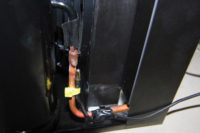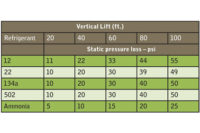Superheat and subcooling are among the most important calculations an HVACR service technician can perform when troubleshooting a system. This article explores some of the new, state-of-the-art, digital, wireless technologies available for measuring system superheat and subcooling. These new tools enable technicians to automate measurements, share data, and save time and money
Making a Wireless Connection
A wireless, digital pressure/temperature (P/T) gauge with clamp-on temperature probes provides a wireless connection to a smart device for measuring an HVACR system’s pressure, temperatures, and superheat and subcooling amounts (See Fig. 1). The wireless device uses Bluetooth technology and can be connected to systems without using a gauge manifold set or hoses (See Fig. 2). The device has a built-in Schrader port for the technician to add or subtract refrigerant according to the superheat and subcooling amounts — again, without the need for gauges or a manifold.
In conjunction with the wireless, digital P/T device, a technician can use a smart device to read, record, send, and share data. The P/T device works with an app that can be downloaded to a smart device from iTunes or Google Play.
The smart device shown in Figure 2 shows a low-side pressure of 113.4 psig for R-410A, which correlates to a low-side saturated vapor temperature of 37.6°F. The P/T conversion is done by the app. The clamp-on temperature probe reads a low-side compressor-in temperature of 53.4°F. These temperatures and pressures are all shown on the right side of the smart device in the service technician’s hand. The difference between the two temperatures (53.4° and 37.6°) is 15.8° of total (compressor) superheat, which is automatically calculated by the app.
The smart device also shows a high-side pressure reading of 296.4 psig for R-410A, which correlates to a high-side saturation temperature of 94.9°. The clamp-on probe on the liquid line at the condenser outlet reads 84.2°. The difference between these two temperatures is 10.7° of liquid subcooling in the condenser.
Service technicians also can use a screenshot feature that allows them to save and email pressure, temperature, subcooling, and superheat readings. This data can now be organized by location and unit for easy tracking and storage history. The Bluetooth radio has a range of up to 400 feet and a 10-hour rechargeable battery life. The app features 98 refrigerant profiles and can be updated.
Subcooling Review
Subcooling is the difference between the measured liquid temperature and the liquid saturation temperature at a given pressure. So, any sensible heat taken away from the 100 percent-saturated liquid point in the condenser can be defined as liquid subcooling. The saturated liquid temperature can be obtained from a P/T relationship chart in the app. As soon as all of the saturated vapor in the condenser changes phase to saturated liquid, subcooling will start to occur, if any more heat is taken away. Remember, this is now a temperature change or sensible heat change, so any drop in temperature of the liquid below the saturation temperature for the pressure at that point will be considered liquid subcooling.
There are two subcooling categories: condenser subcooling and total subcooling. Condenser subcooling is the liquid subcooling present at the condenser’s bottom. It can be measured by subtracting the actual condenser liquid-out temperature from the saturation temperature measured at the condenser outlet by the wireless, digital P/T gauge.
Here is the formula:
[Condensing temperature (measured by wireless, digital P/T gauge)] — [Condenser’s liquid-out temperature (measured by temperature probe)] = Condenser subcooling
When subcooled, the refrigerant is not generating or losing any vapor pressure, so there is no P/T relationship, and a P/T chart cannot be used. Thus, the condenser outlet temperature must be measured with the clamp-on temperature probe. The saturated temperature, on the other hand, can be acquired from the condensing pressure read from the wireless, digital gauge on the condenser’s outlet. This is because a P/T relationship does exist in a saturated condition. If pressure drops exist in the system, the pressure must be measured where the temperature was taken to get an accurate liquid subcooling amount.
Total subcooling includes condenser subcooling and liquid-line subcooling. It starts at the 100 percent-saturated vapor point in the condenser and ends at the metering device inlet.
Superheat Review
Superheat is probably the most talked about, yet misunderstood, technical term used by service technicians. Superheat is a measured value. It is the difference between two temperatures — the actual temperature of refrigerant vapor at a certain point and the saturation temperature of the refrigerant.
Superheat on a system’s low side can be divided into two types: evaporator superheat and total or (compressor) superheat. Evaporator superheat starts at the 100 percent-saturated vapor point in the evaporator and ends at the outlet of the evaporator. The 100 percent-saturated vapor point is the point where all the liquid has just turned to vapor. The temperature at this point can be measured by the wireless, digital, P/T gauge. The evaporator outlet is where the remote bulb of the thermal expansion valve (TXV) is located. Technicians can use the clamp-on temperature probe at the evaporator outlet to obtain the evaporator outlet temperature. The wireless, digital pressure gauge at the same point as the temperature reading will give technicians the saturated vapor temperature. Most manufacturers of larger evaporators supply a Schrader fitting at the evaporator outlet and close the remote bulb of the TXV for measuring pressure.
Compressor superheat is all the superheat the compressor experiences. It includes evaporator superheat and suction line superheat. Both the saturation pressure (temperature) and superheated temperature must be measured as closely as possible to the compressor at the compressor’s inlet (See Fig. 3).
Publication date: 2/9/2015
Want more HVAC industry news and information? Join The NEWS on Facebook, Twitter, and LinkedIn today!










